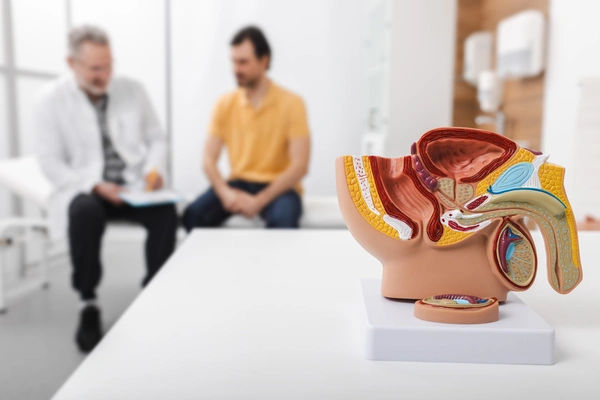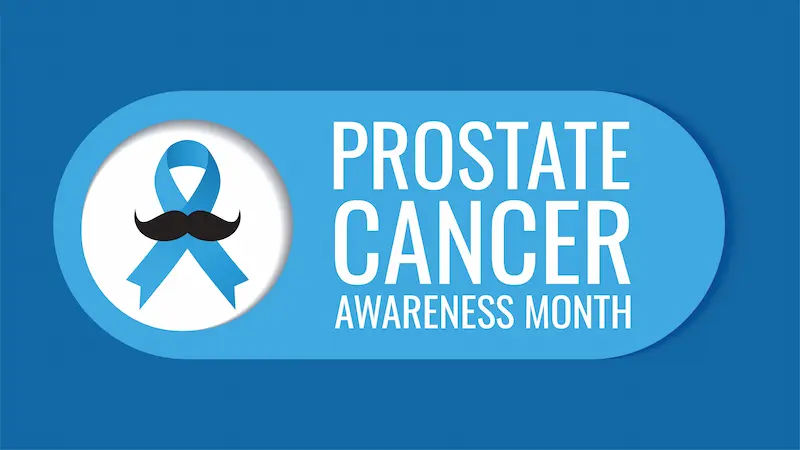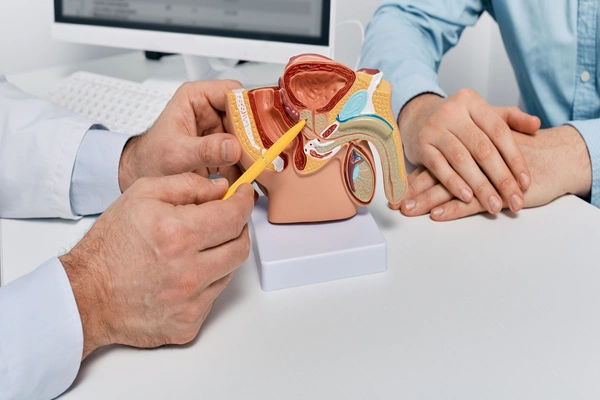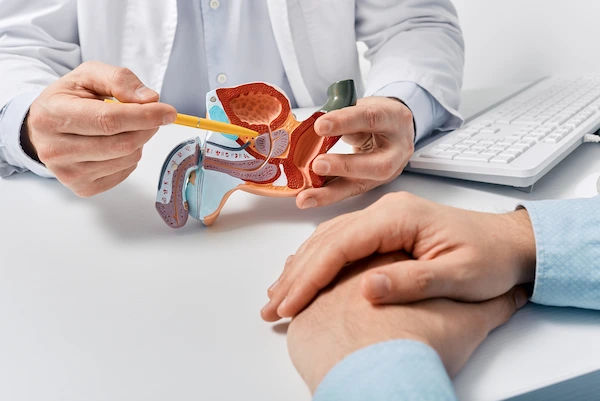Guide to Prostate Diseases And Its Management
Learn about common prostate diseases—BPH, prostatitis, and prostate cancer—their causes, symptoms, and treatment options. Discover how to manage prostate health confidently with lifestyle, medical, and digital care tools.


Introduction
Prostate problems are common as men age, and the symptoms can be frustrating: frequent trips to the bathroom at night, a hesitant stream, pelvic discomfort, or worries about cancer. The good news is that most prostate diseases are manageable, and many can be treated with simple lifestyle changes or minimally invasive procedures.
In this complete guide to prostate diseases and their management, we’ll explain how the prostate works, what can go wrong, and how to tell the difference between benign conditions like BPH and prostatitis versus prostate cancer. You’ll learn about the symptoms to watch for, the tests you may need, and practical treatment choices—from self-care techniques to medications, procedures, and cancer therapies. You’ll also get evidence-based insights on screening, side effects, sexual health, and follow-up, plus tips for using telehealth and home lab collection services.
If symptoms persist or you’re worried about your risk, help is close at hand. Let’s demystify the prostate so you can
make informed decisions, navigate care confidently, and protect your long-term health.
The Prostate in Brief: What It Does and Why It Matters
Understanding the prostate’s role is key to identifying and managing health issues early.
Structure and Function
The prostate is a small, walnut-sized gland located just below the bladder and around the urethra—the tube that carries
urine out of the body. Its main function is to produce seminal fluid, which nourishes and transports sperm. Because it
surrounds the urethra, even slight enlargement or inflammation can affect urinary flow.
Consult a Top Urologist for Personalised Advice
Hormonal Influence
As men age, hormonal changes—particularly the conversion of testosterone to dihydrotestosterone (DHT)—can trigger
cell growth, leading to benign enlargement (BPH). The gland can also become inflamed (prostatitis) or, less commonly,
cancerous (prostate cancer).
Unique insight: Urinary symptoms are not always caused by size alone. Increased muscle tone in the prostate and
bladder neck can also affect flow, explaining why alpha-blockers often bring quick relief.
The Big Three Prostate Diseases at a Glance
Knowing the main prostate conditions helps you understand which symptoms to watch for and how they differ.
Benign Prostatic Hyperplasia (BPH)
A non-cancerous enlargement that compresses the urethra, causing symptoms like a weak stream, straining, and
nocturia. Management options include lifestyle changes, medication, or minimally invasive procedures like UroLift or
Rezūm.
Prostatitis and Chronic Pelvic Pain Syndrome (CPPS)
Inflammation or infection of the prostate may cause pelvic pain, urinary burning, or discomfort with ejaculation. Acute
bacterial prostatitis needs antibiotics, while chronic prostatitis or CPPS often requires a combination of medication,
pelvic therapy, and stress management.
Prostate Cancer
The most common male cancer, often slow-growing and symptomless in early stages. Risk increases with age and
family history. Screening with PSA is a personal decision—active surveillance can delay or avoid treatment for low-risk
cases.
Symptoms You Shouldn’t Ignore
Early detection of warning signs can prevent complications and improve outcomes.
Lower Urinary Tract Symptoms (LUTS)
- Frequent urination, urgency, and nocturia.
- Hesitancy, weak stream, dribbling.
- Pelvic or back pain, painful ejaculation.
Signs of Infection
Fever, chills, and severe pelvic pain suggest acute bacterial prostatitis, which needs urgent medical care.
Cancer Red Flags
Blood in urine or semen, weight loss, or bone pain. Persistent urinary issues should always be checked.
Practical tip: Keep a bladder diary for three days—it helps your clinician distinguish causes and tailor management.
How Prostate Diseases Are Diagnosed
Accurate diagnosis guides effective treatment and prevents unnecessary interventions.
Clinical Assessment
Diagnosis starts with history, examination, and sometimes a digital rectal exam (DRE) to feel for enlargement or
abnormalities.
Key Tests
- PSA blood test – helps detect abnormalities.
- Urinalysis – checks for infection or blood.
- Ultrasound or bladder scan – assesses urine retention.
Imaging and Biopsy
Modern imaging (mpMRI) helps identify suspicious areas before biopsy. Transperineal biopsy is now preferred for
accuracy and safety.
Access and convenience: Home test collection for PSA or urine through Apollo24|7 saves time and supports faster
diagnosis.
Managing BPH: From Lifestyle Tweaks to Procedures
Tailored management helps balance symptom relief, safety, and long-term outcomes.
Lifestyle Adjustments
- Limit fluids before bedtime.
- Reduce caffeine and alcohol.
- Try double voiding to empty fully.
Medication Options
- Alpha-blockers improve flow quickly.
- 5-alpha-reductase inhibitors shrink the prostate gradually.
- Combination therapy may be best for severe symptoms.
Procedures and Surgery
Minimally invasive options like UroLift and Rezūm preserve sexual function. Traditional TURP or HoLEP are
effective for larger prostates.
Unique insight: List your top treatment priorities—speed of relief, durability, or preserving ejaculation—to guide
discussions with your doctor.
Managing Prostatitis and Chronic Pelvic Pain
A flexible, multi-pronged approach brings lasting relief for chronic pelvic symptoms.
Types and Treatment
- Acute bacterial prostatitis requires urgent antibiotics.
- Chronic bacterial prostatitis – may need longer therapy.
- Chronic pelvic pain syndrome (CPPS) – managed through pelvic floor therapy, relaxation, and medication for pain relief.
Lifestyle and Pain Management
Use heat therapy, stress reduction, and pelvic relaxation techniques. Avoid irritants like alcohol or spicy foods.
Unique insight: Create a “flare playbook” with 2–3 steps for bad days (for example, warm bath + breathing + pain
relief).
Prostate Cancer: Screening, Staging, and Treatment Choices
Awareness and informed choices reduce anxiety and improve long-term survival.
Screening and Risk
PSA testing between ages 55–69 should be individualised. Discuss your family history and values before deciding.
Diagnosis and Monitoring
MRI and targeted biopsy improve accuracy. Low-risk cancers can often be managed with active surveillance instead of immediate treatment.
Treatment Options
- Surgery (radical prostatectomy) – removes the gland.
- Radiation therapy controls cancer with fewer operations.
- Focal therapy – a selective option in some cases.
Unique insight: Ask about your personal risk, side effects, and recovery expectations before committing to treatment.
Living Well With Prostate Disease
Small daily changes can significantly improve prostate and overall health.
Diet and Exercise
Focus on whole foods, healthy fats, and regular exercise. Maintain a healthy weight to reduce symptom severity.
Sleep and Recovery
Good sleep supports hormone balance and urinary health. Manage sleep apnoea and avoid large evening drinks.
Sexual Health
Open communication and counselling help manage changes in function or confidence.
Access tip: Use Apollo24|7 home collection for PSA or urine follow-up to simplify ongoing care.
Navigating Care and Digital Tools
Modern digital healthcare makes prostate management easier and more accessible.
Choosing Specialists
See a urologist for BPH and prostatitis; add a radiation oncologist for prostate cancer. Ask about experience with
specific procedures.
Using Telehealth
Ideal for reviewing results, medication adjustments, or symptom tracking between visits.
Questions to Ask Your Clinician
- What are my treatment options and side effects?
- How will my quality of life change?
- What’s the follow-up plan?
Conclusion
The prostate plays a small but vital role in men’s health. Benign enlargement, inflammation, and cancer can cause similar symptoms but require different approaches. Recognising persistent urinary changes, pelvic discomfort, or abnormal PSA results early allows tailored management—from lifestyle measures and medications to precise procedures or cancer therapies.
Modern tools like mpMRI, targeted biopsy, and decision aids improve safety and confidence in care. Most men achieve excellent long-term outcomes when they follow their plan and maintain open communication with their medical team.
If symptoms persist or you’re unsure about screening, consult a doctor online with Apollo24|7 for expert advice. Their home lab collection for PSA and urinalysis makes prostate monitoring convenient and stress-free.
Consult a Top Urologist for Personalised Advice
Consult a Top Urologist for Personalised Advice
Dr S K Singhanina
Urologist
25 Years • MBBS/MS/DNB AND MCH UROLOGY
Guwahati
Apollo Clinic Guwahati, Assam, Guwahati

Dr. Sandeep Maheswara Reddy Kallam
Urologist
6 Years • MBBS, MS (General Surgery), M Ch (Genito-Urinary Surgery), Post Doctoral Fellowship in Uro-Surgical Oncology
Visakhapatnam
Dr. SANDEEP MAHESWARA REDDY K _- best Urologist in visakhapatnam, Visakhapatnam
(275+ Patients)

Dr. Pavan Kumar S K
Urologist
11 Years • MBBS, MS , Mch( Urology) DNB (Urology)
Bengaluru
Apollo Clinic, JP nagar, Bengaluru

Dr. Sudhakar G V
Urologist
25 Years • MBBS, MS(Gen.Surgery), DNB Urology
Bengaluru
Apollo Clinic, JP nagar, Bengaluru

Dr. Pradeep Champawat
Urologist
10 Years • MBBS, MS, DNB Urology
Delhi
Apollo Hospitals Indraprastha, Delhi
(175+ Patients)
Consult a Top Urologist for Personalised Advice
Dr S K Singhanina
Urologist
25 Years • MBBS/MS/DNB AND MCH UROLOGY
Guwahati
Apollo Clinic Guwahati, Assam, Guwahati

Dr. Sandeep Maheswara Reddy Kallam
Urologist
6 Years • MBBS, MS (General Surgery), M Ch (Genito-Urinary Surgery), Post Doctoral Fellowship in Uro-Surgical Oncology
Visakhapatnam
Dr. SANDEEP MAHESWARA REDDY K _- best Urologist in visakhapatnam, Visakhapatnam
(275+ Patients)

Dr. Pavan Kumar S K
Urologist
11 Years • MBBS, MS , Mch( Urology) DNB (Urology)
Bengaluru
Apollo Clinic, JP nagar, Bengaluru

Dr. Sudhakar G V
Urologist
25 Years • MBBS, MS(Gen.Surgery), DNB Urology
Bengaluru
Apollo Clinic, JP nagar, Bengaluru

Dr. Pradeep Champawat
Urologist
10 Years • MBBS, MS, DNB Urology
Delhi
Apollo Hospitals Indraprastha, Delhi
(175+ Patients)
More articles from Prostate cancer
Frequently Asked Questions
1) Are frequent urination and a weak stream always due to BPH?
No. Overactive bladder, prostatitis, or certain medicines can mimic BPH. Proper testing helps identify the true cause.
2) How long does prostatitis take to heal?
Acute infections improve within weeks; chronic pelvic pain needs a longer-term approach with therapy and lifestyle support.
3) Should I get a PSA test every year?
Discuss this with your clinician. Men aged 55–69 may test every 1–2 years based on individual risk and preference.
4) Will a BPH procedure affect sexual function?
Minimally invasive procedures usually preserve ejaculation; traditional surgeries may not. Ask your doctor before treatment.
5) Does cycling raise PSA or worsen prostate symptoms?
Yes, intense cycling can temporarily raise PSA or cause discomfort. Avoid cycling 24–48 hours before testing.




